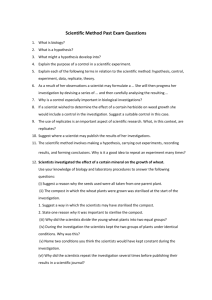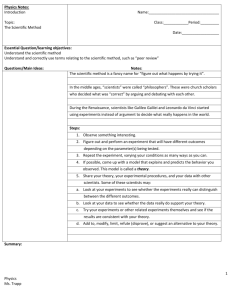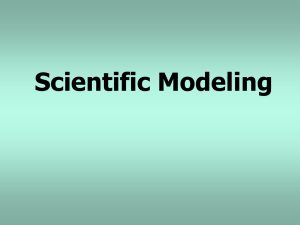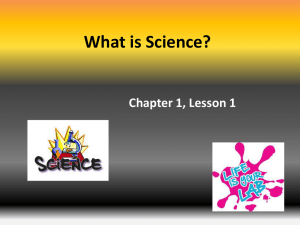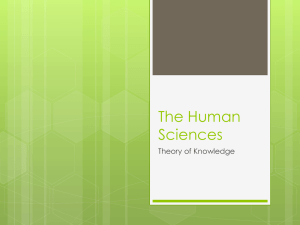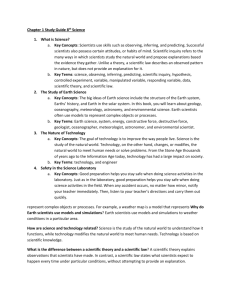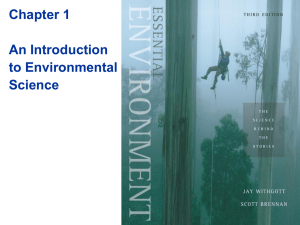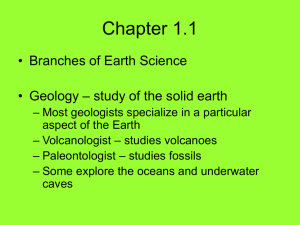Scientific Method PowerPoint
advertisement
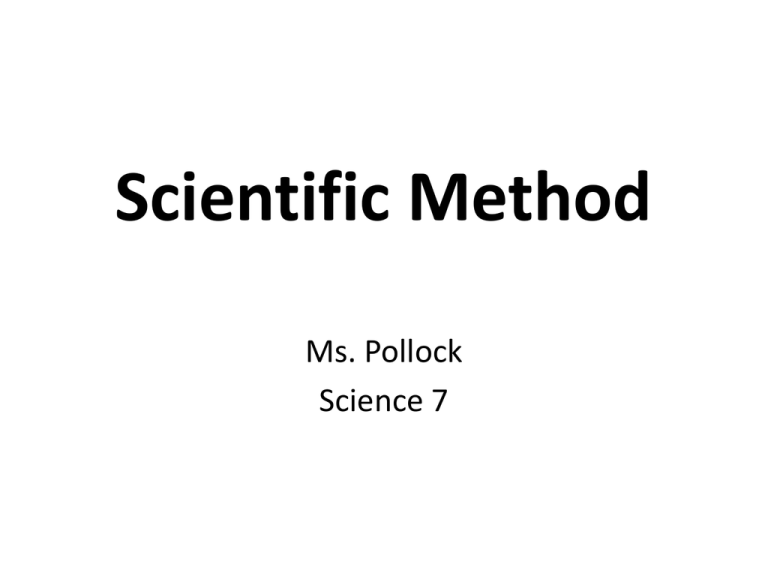
Scientific Method Ms. Pollock Science 7 Learning Targets: 1. IWBAT identify the parts and steps to planning an investigation or experiment. 2. IWBAT create tables, graphs, and write conclusions in order to explain the results of the investigation/experiment. The scientific method is the process that scientists use to learn new information about our natural world. In every well designed experiment there are 3 major variables: 1. Manipulated Variable (MV) This is what is being changed on purpose by the person doing the experiment The overall category for groups that are being compared or tested Stands alone; only 1 MV in an experiment Math = independent variable “manipulate” means to change or alter something on purpose In every well designed experiment there are 3 major variables: 1. Manipulated Variable (MV) 2. Responding Variable (RV) The factor(s) that are being measured or observed The “data or results” of experiment The factor(s) that is changing due to the MV Math = dependent variable In every well designed experiment there are 3 major variables: 1. Manipulated Variable (MV) 2. Responding Variable (RV) 3. Controlled Variables (CVs) These are factors that have to be kept the same or “controlled so the data can be compared Not all factors in an experiment can be controlled, this all depends on the experiment itself In any well designed experiment there is only 1 MV, 1 or more RVs, and the rest should be CVs as much as possible. There are 2 types of Data that can be collected in an experiment: 1. Quantitative Data This is data that is in the form of numbers; so measuring speed, mass, height, etc… are examples of this kind of data. “Quantity” – the amount of something 2. Qualitative Data This is data that is in the form of descriptions; colors, smells, textures, etc… are examples of this kind of data “Quality” – the different traits or characteristics of something A scientist or an everyday person has 2 types of thoughts: 1. Observations Stating exactly what is being seen, smelled, touched, tasted, or heard without any opinions attached to what is happening. Example: The banana is yellow or 1 foot long 2. Inference This is taking an observation and making some conclusion/opinion/assumption about it. Example: Bananas grow where there is lots of sunlight because they are yellow. 7 steps that scientists use 1. Scientific Question: The question has to be answered through an experiment MV & RV are written in the question Testable, measurable, and specific *Not all questions are scientific; i.e. “What is the meaning of life?”* This question has no way of being tested so that everyone will get similar results, therefore it is not a scientific question. 7 steps that scientists use 2. Research: This is doing some background reading & notes on the question or interested topic to become an expert in that area Doing research helps scientists write a good hypothesis Doing research helps scientists design good experiments 7 steps that scientists use 3. Hypothesis: This is the prediction or educated guess to the scientific question A hypothesis statement includes the MV and how it is changed, RV and how it is changed, and a reason. If the (Manipulated variable) (Describe how it will be changed) then the __(Responding variable) will (Describe the effect) because….. 7 steps that scientists use 4. Materials and Procedures: “Material List” is the part with all tools and items needed for the experiment, write in a list form “Procedure” is the directions on how to do experiments. It is specific and in step-by-step format. Every good procedure has 6 parts: 7 steps that scientists use 4. Materials and Procedures: 1. 2. 3. 4. 5. 6. Logical, orderly steps MV is mentioned in the steps RV is in the steps CV(s) are mentioned in the steps Be Specific Steps show repeated trials 7 steps that scientists use 5. Data: This is the place where you record all your measurements and observations The recording of data is done in an organized way like a data table or t-chart 7 steps that scientists use 5. Data: Making a data table (5 parts) 1. MV Heading 2. RV Heading 3. Organized = columns and rows 4. Appropriate Units – found in parenthesis: example (min) 5. Repeated Trials 7 steps that scientists use 6. Data Analysis: This is a time to review the data to determine if a conclusion can be made To look for any patterns in the data or anything unusual This is a time to make graphs to look for patterns or unusual data 6. Data Analysis: In every experiment there are 2 important questions to ask yourself, so that a conclusion can be made: (you must say yes to all these questions in order to make honest inferences/conclusions) Repeatability: Can this experiment/investigation be repeated by another person and will they get the same results? Validity (Valid): “Is the data accurate and reasonable?” “Is the data in the repeated trials close together or way off?” “Is the data good enough to say the hypothesis is true or false? 7 steps that scientists use 7. Conclusion: This is either a paragraph or more explaining 1. What the experiment was about 2. If the hypothesis is true or false 3. Discuss high and low data 4. What the data means 5. Any errors 6. Infer how the data can be applied


